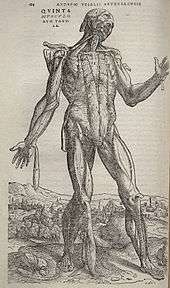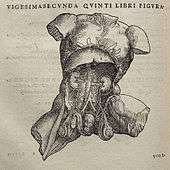De humani corporis fabrica
 Title page. The full title is Andreae Vesalii Bruxellensis, scholae medicorum Patauinae professoris, de Humani corporis fabrica Libri septem (Andreas Vesalius of Brussels, professor at the school of medicine at Padua, on the fabric of the Human body in seven Books). | |
| Author | Andreas Vesalius |
|---|---|
| Illustrator | 'Studio of Titian' |
| Country | Italy |
| Subject | Anatomy |
| Genre | Illustrated textbook |
| Publisher | School of medicine, Padua |
Publication date | 1543 |

De humani corporis fabrica libri septem (Latin for "On the fabric of the human body in seven books") is a set of books on human anatomy written by Andreas Vesalius (1514–1564) and published in 1543. It represented a major advance in the history of anatomy.
The collection of books is based on his Paduan lectures, during which he deviated from common practice by dissecting a corpse to illustrate what he was discussing. Dissections had previously been performed by a barber surgeon under the direction of a doctor of medicine, who was not expected to perform manual labour. Vesalius's magnum opus presents a careful examination of the organs and the complete structure of the human body. This would not have been possible without the many advances that had been made during the Renaissance, including artistic developments in literal visual representation and the technical development of printing with refined woodcut engravings. Because of these developments and his careful, immediate involvement, Vesalius was able to produce illustrations superior to any produced previously.
Books of the collection
Vesalius arranged his work into seven books.
Book 1: The Bones and Cartilages
The first book constitutes about a quarter of the entire collection. It presents Vesalius' observations on human bones and cartilage, which he collected from cemeteries. It covers the physical appearance of human bones and the differentiation of human bones and cartilage by function. In each chapter Vesalius describes the bones in great detail, explaining their physical qualities in different ways. In the opening chapters, Vesalius "gives general aspects of bones and skeletal organisation, dealing with the differences in texture, strength, and resilience between bone and cartilage; explaining the complex differences between types of joints and reviewing some basic elements of descriptive techniques and terminology." A major theme of this book is whether Galen described the bones of the human skeleton accurately. When Vesalius lectured on the human skeleton, he also had to present the bones of animals to give credibility to Galen's observations.

Book 2: The Ligaments and Muscles
Here Vesalius describes the structure of the muscles, the agents used in creating movement by the body, and the material used to hold the joints together. Through his observations of butchers cutting meat, he was able to incorporate the skills they used in the dissection of the human body. The order in which to dissect a human body to effectively observe each muscle in the body is laid out. Each illustration displays a deepening view of the human body which can be followed while dissecting a human body. Vesalius also mentions the instruments needed to perform a dissection. Here Vesalius begins to describe how Galen's anatomical descriptions do not match his own observations. In order not to show disrespect to Galen, he suggests Galen's use of anatomical structure is in fact correct, but not for humans. He even continues to describe some of the structures in the way Galen would.
Book 3: The Veins and Arteries, Book 4: The Nerves
In Books 3 and 4, Vesalius describes the veins, arteries, and nerves as vessels, but notes their differing physical structure: veins and arteries contains a hollow channel, but nerves do not. Vesalius describes the route by which air travels through the lungs and the heart. He describes this process as "a tree whose trunks divide into branches and twigs". He also describes how the body contains four veins (the portal vein, the venae cavae, the artery-like vein [now understood as the Pulmonary Vein], and the umbilical vein) and two arteries (the aorta, and the vein-like artery [now understood as the Pulmonary Artery] as being the main vessels which branch out into smaller veins and arteries. Vesalius lists some six hundred vessels in his tabulation of arteries, veins and nerves, but fails to mention the smaller vessels located in the hands and feet, the terminal vessels of the cutaneous nerves, or the vessels in the lungs and liver.
Book 5: The Organs of Nutrition and Generation
Vesalius gives detailed descriptions of the organs of nutrition, the urinary system, and the male and female reproductive systems. The alimentary and reproductive systems each make up about forty percent of this book, and the description of the renal system and the correct technique for dissecting it makes up the remainder. In the final chapter, the longest chapter of the entire collection, Vesalius gives detailed step-by-step instructions on how to dissect the abdominopelvic organs. In the first half of the book, Vesalius describes the peritoneum, the esophagus, the stomach, the omentum, the intestines and the mesentery. He then goes on to describe the liver, gall bladder, and the spleen. Finally, he describes the kidneys, the bladder, and the ureters. Although Vesalius was unfamiliar with the anatomy of pregnancy, he provides illustrations of the placenta and the fetal membrane, making anatomical reference to Galen by comparing a dog's reproductive organs to those of a human.
Book 6: The Heart and Associated Organs, Book 7: The Brain

These books describe the structure and functions of the heart and the organs of respiration, the brain and its coverings, the eye, the organs of sensation, and the nerves of the limbs. A chapter is also devoted to the dissection of the eye. Vesalius describes the organs of the body in great detail by commenting "on the variable strength of the attachment of the pleura to the thoracic walls, the strong attachment of the pericardium to the diaphragm, the shape and orientation of the ventricles of the heart, and the description of the semilunar valves." He closes each book with a chapter on the correct way to dissect the heart and the brain respectively.
Galen's errors
The prominent Greek physician, surgeon and philosopher in the Roman empire had written on anatomy among other topics, but his work remained largely unchecked until the time of Vesalius. The Fabrica rectified some of Galen's worst errors, including the notion that the great blood vessels originated from the liver. While examining a human corpse, Vesalius discovered that Galen's observations were inconsistent with those of his, due to Galen's use of animal (dog and monkey) cadavers. Even with his improvements, however, Vesalius clung to some of Galen's errors, such as the idea that a different type of blood flowed through veins than through arteries. It was not until William Harvey's work on the circulation of the blood (De Motu Cordis, 1628) that this misconception of Galen's would be rectified in Europe.

Publication
1543 edition
Vesalius had the work published at the age of 28, taking great pains to ensure its quality, and dedicated it to Charles V, Holy Roman Emperor. The more than 250 illustrations are of great artistic merit and are generally attributed by modern scholars to the "studio of Titian" rather than Johannes Stephanus of Calcar, who provided drawings for Vesalius' earlier tracts. The woodcuts were greatly superior to the illustrations in anatomical atlases of the day, which were never made by anatomy professors themselves. The woodcut blocks were transported to Basel, Switzerland, as Vesalius wished that the work be published by one of the foremost printers of the time, Johannes Oporinus. Vesalius' written directions to Oporinus (the iter) were so valuable the printer decided to include them. The illustrations were engraved on wooden blocks, which allowed for very fine detail.[1]
1555 edition
A second edition was published in 1555. Annotations in a copy of that edition donated to the Thomas Fisher Rare Book Library, University of Toronto, have been identified as Vesalius's own, showing that he was contemplating a third edition, never achieved.[2]
Reception
The success of Fabrica recouped the work's considerable expense, and brought Vesalius European fame, partly through cheap unauthorized copies. He was appointed physician to the Holy Roman Emperor Charles V; Vesalius presented him with the first published copy (bound in silk of imperial purple, with specially hand-painted illustrations not found in any other copy). To accompany the Fabrica, Vesalius published a condensed and less expensive Epitome: at the time of publication in 1543, it cost 10 batzen.[3] As a result, the Epitome became more widely seen than the Fabrica; it contained eight anatomical engravings that condensed visual material from the Fabrica, one illustration of the human skeleton taken directly from the Fabrica, and two new woodcut plates.[4]
Surviving copies
A copy of the book bound in tanned human skin was donated to Brown University's John Hay Library by an alumnus. Its cover is "polished to a smooth golden brown" and, according to those who have seen the book, it looks like fine leather. Covering medical books in human skin was not an uncommon practice until the 18th century, utilizing the skin of executed convicts and poor people who died with no one to claim the body.[5]
References
- ↑ Brian S. Baigrie Scientific Revolutions, pages 40–49 has more information and a translation of Vesalius' preface.
- ↑ "U of T acquires annotated copy of Vesalius's great anatomical book". University of Toronto. 2013-03-26.
- ↑ Kusukawa, Sachiko. "De humani corporis fabrica. Epitome (CCF.46.36)". Cambridge Digital Library. Retrieved 1 August 2016.
- ↑ M. Kemp, "A drawing for the Fabrica; and some thoughts upon the Vesalius muscle-men." Medical History, 1970
- ↑ Johnson, M.L. (2006-01-08). "Libraries own books bound in human skin". The Barre Montpelier Times Argus. The Associated Press. Retrieved 2009-10-06.
Bibliography
- O'Malley, C.D. Andreas Vesalius of Brussels, 1514-1564. Berkeley: University of California Press, 1964.
- Vesalius, Andreas. De humani corporis fabrica libri septem [Title page: Andreae Vesalii Bruxellensis, scholae medicorum Patauinae professoris De humani corporis fabrica libri septem]. Basileae [Basel]: Ex officina Joannis Oporini, 1543.
Translations
- Vesalius, Andreas. On the Fabric of the Human Body, translated by W. F. Richardson and J. B. Carman. 5 vols. San Francisco and Novato: Norman Publishing, 1998-2009.
- Vesalius, Andreas. The Fabric of the Human Body. An Annotated Translation of the 1543 and 1555 Editions, edited by D.H. Garrison and M.H. Hast, Northwestern University, 2003.
- Vesalius, Andreas. La Fabrique du corps humain (1543), livre I dans La fabrique de Vésale et autres textes. First translation in French by J. Vons et S. Velut, Paris, BIU Santé, 2014.
External links
 Media related to De humani corporis fabrica at Wikimedia Commons
Media related to De humani corporis fabrica at Wikimedia Commons- Turning the Pages Online. A U.S. National Library of Medicine project to digitize images and plates from "rare and beautiful historic books in the biomedical sciences".
- Andreas Vesalius. De Humani Corporis Fabrica. Historical Anatomies on the Web. Selected images from the original work. National Library of Medicine.
- De Humani Corporis Fabrica online — translated with full images, from Northwestern University
- Andreae Vesalii bruxellensis, scholae medicorum Patavinae professoris, de Humani corporis fabrica Libri septem, Basileae, ex officina Ioannis Oporini, June 1543.
- Selected images from De humani corporis fabrica From The College of Physicians of Philadelphia Digital Library